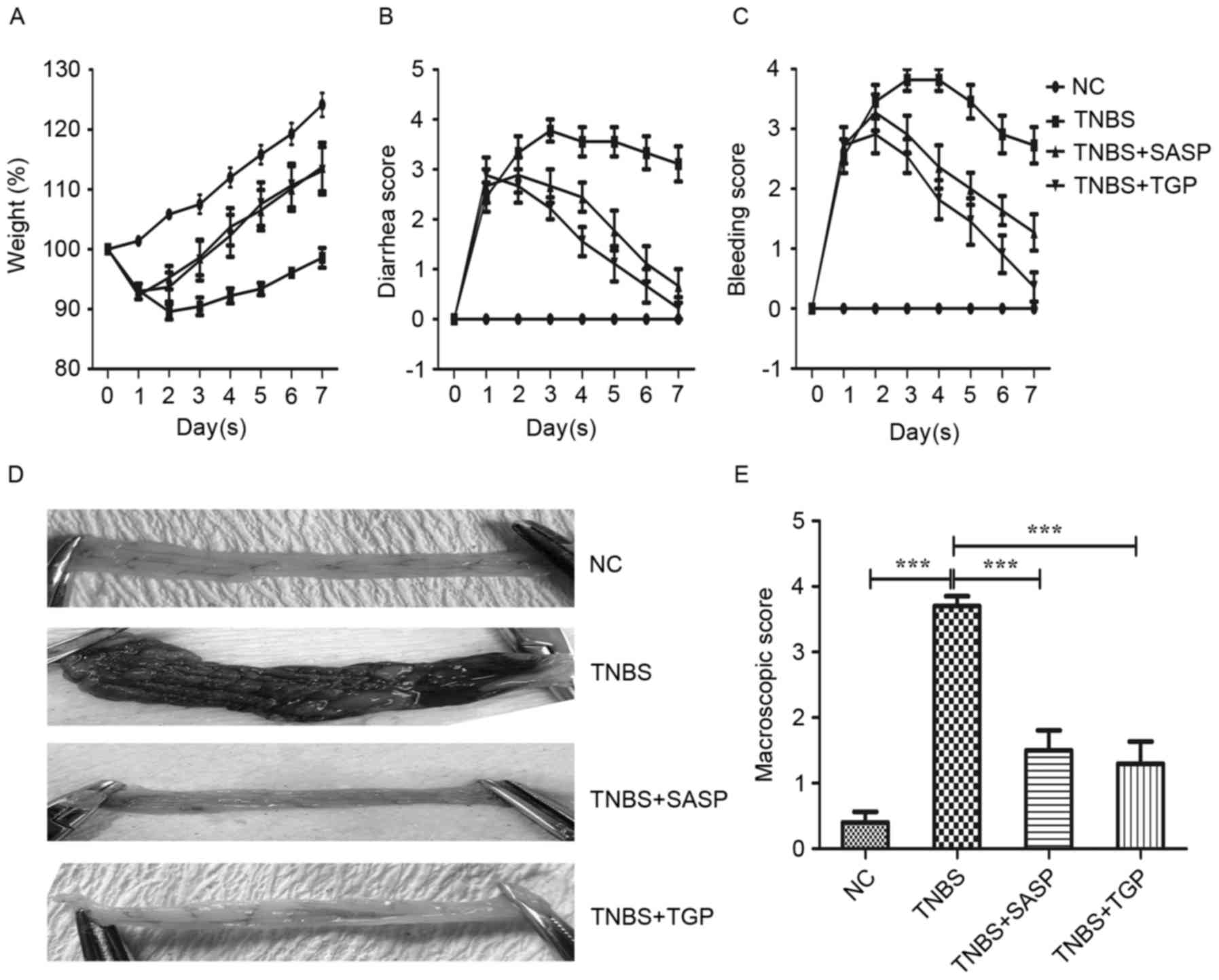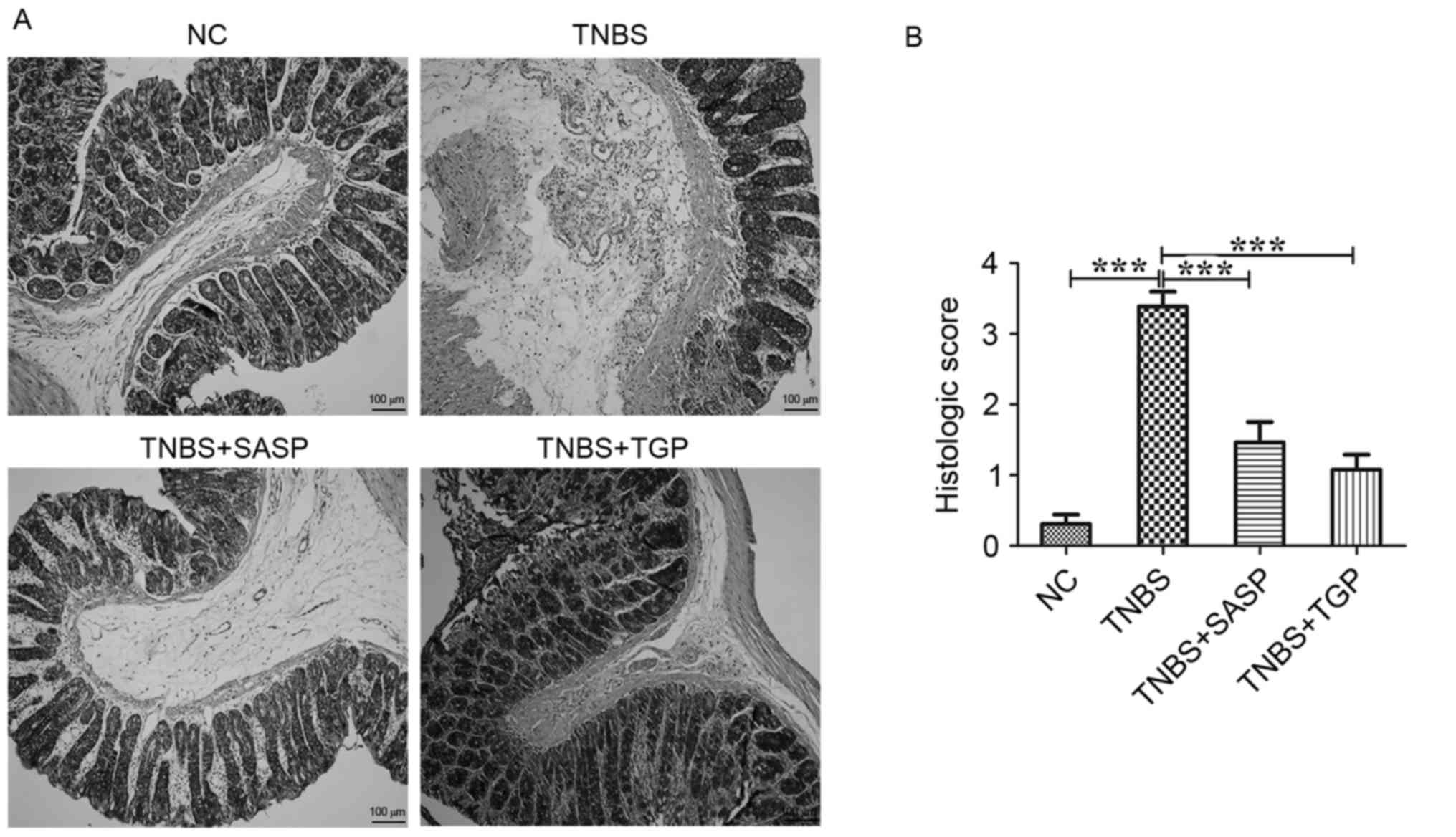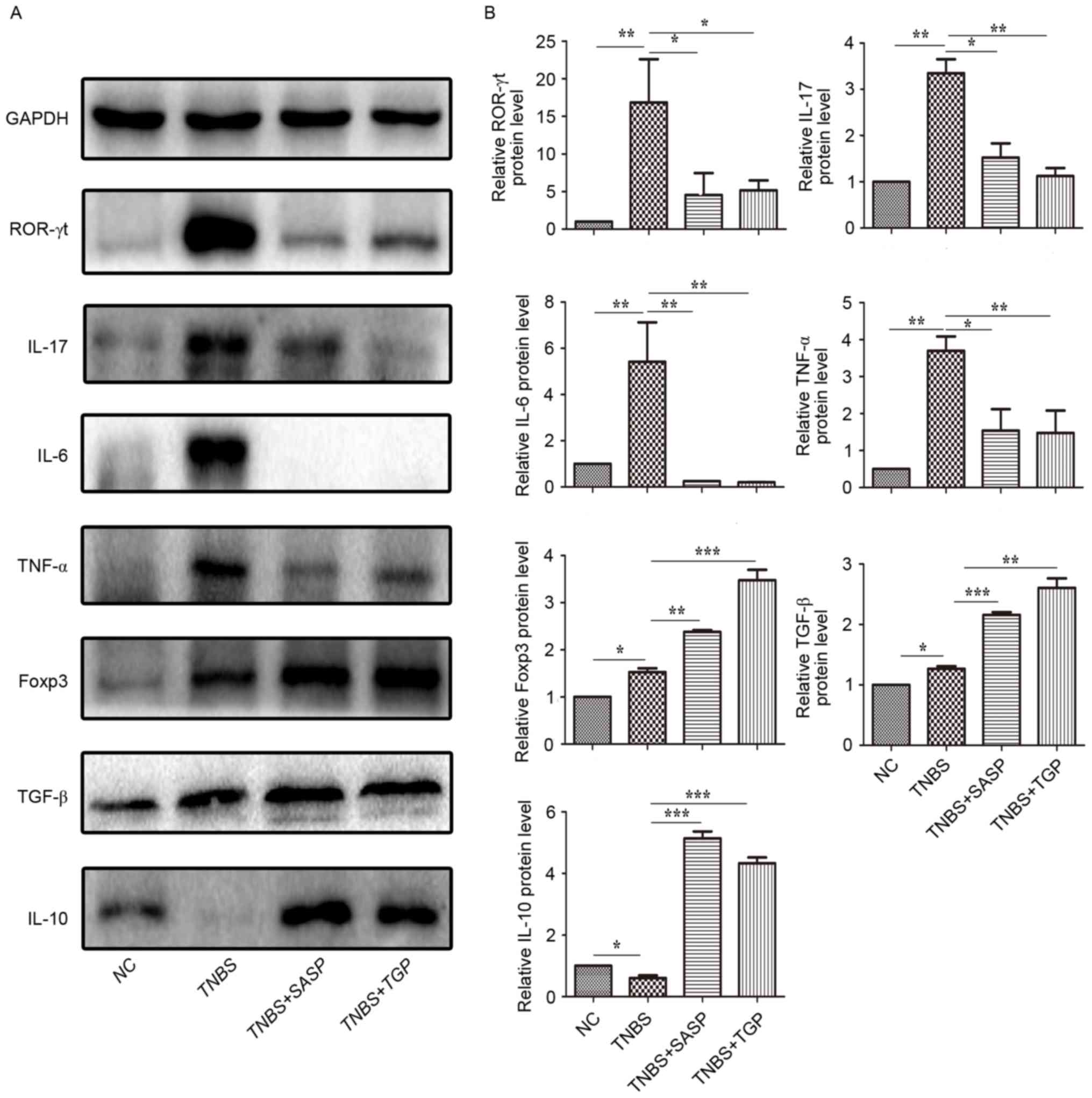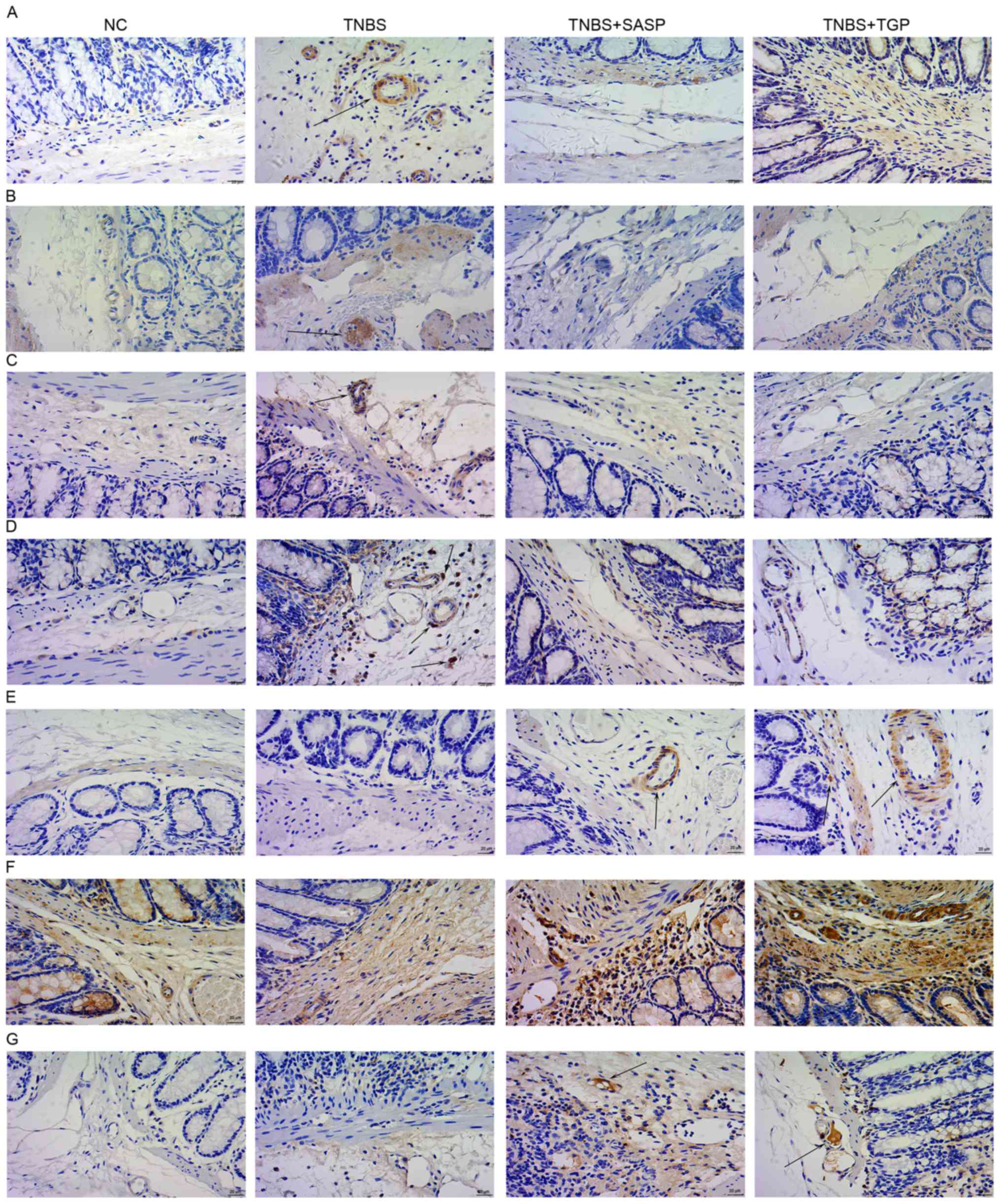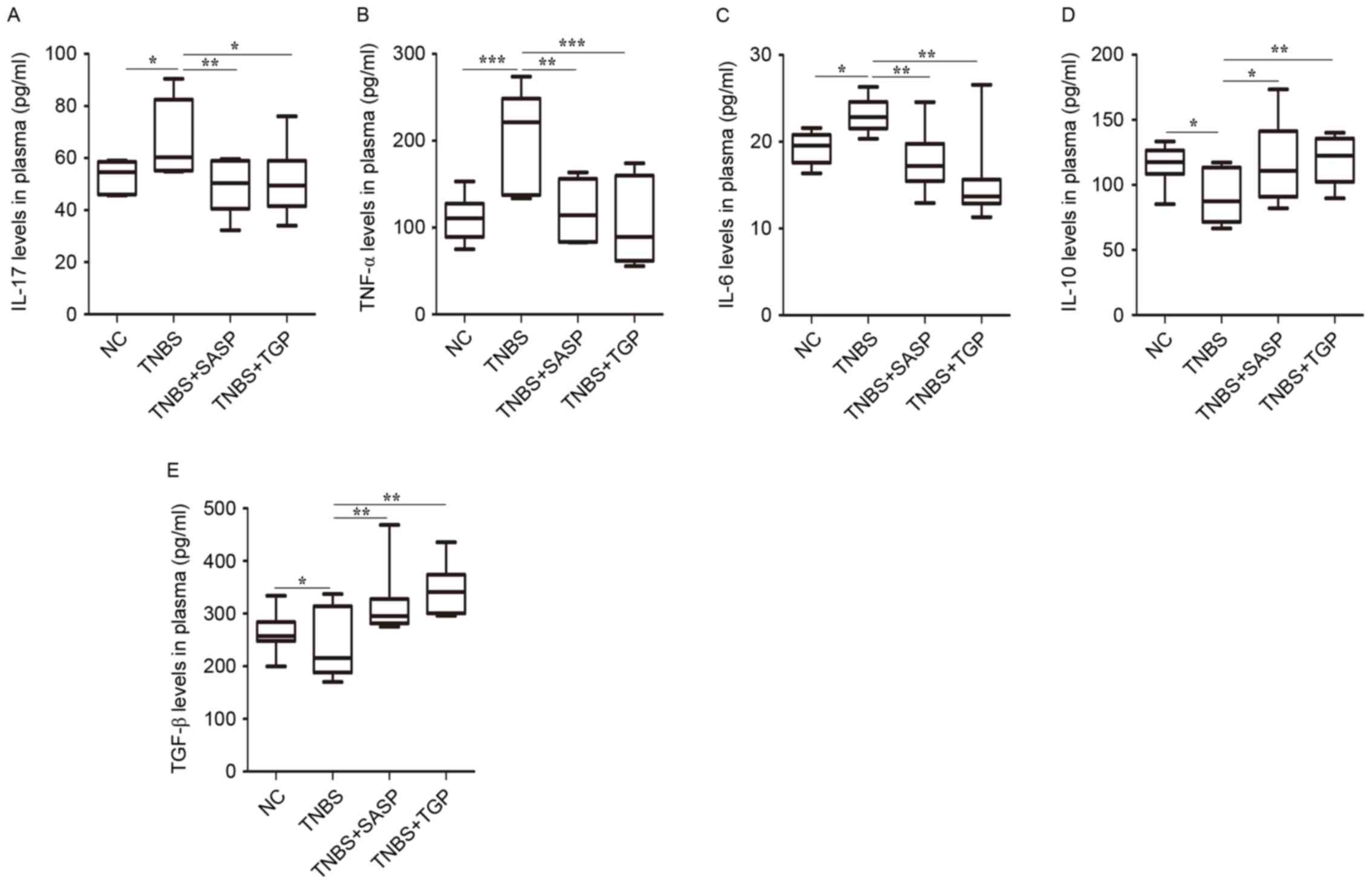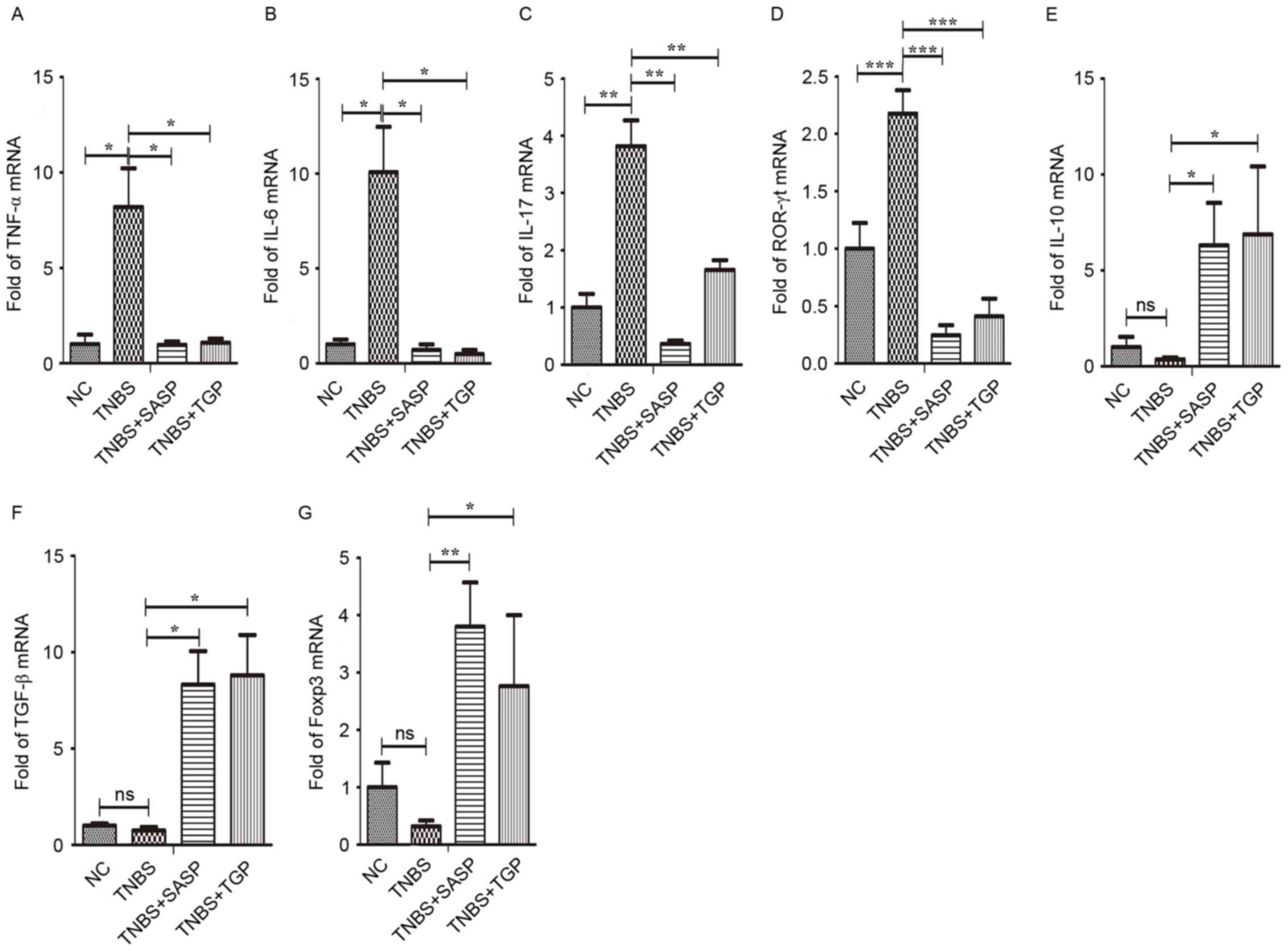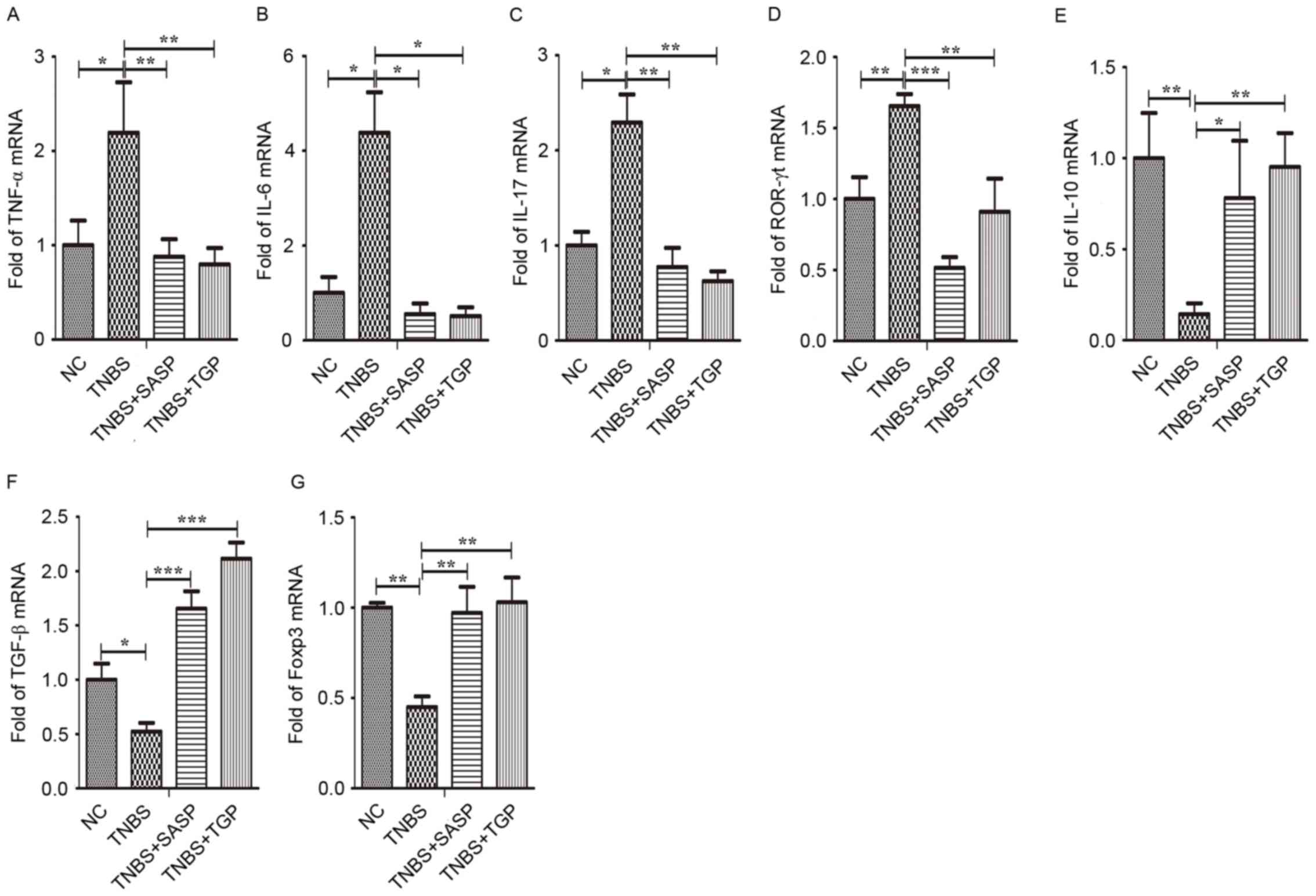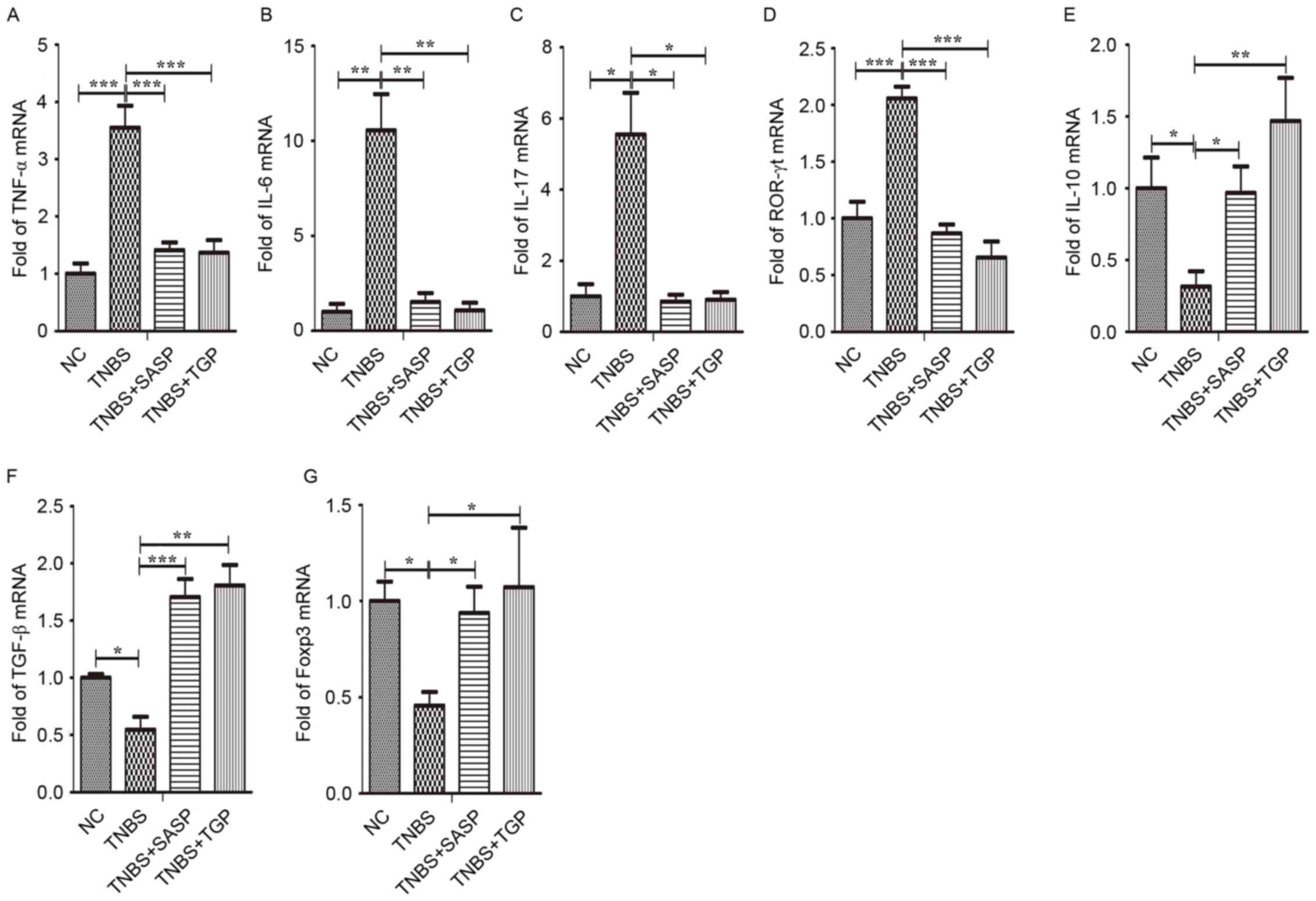Total glucosides of paeony ameliorates TNBS‑induced colitis by modulating differentiation of Th17/Treg cells and the secretion of cytokines
- Authors:
- Published online on: September 25, 2017 https://doi.org/10.3892/mmr.2017.7598
- Pages: 8265-8276
Abstract
Introduction
Inflammatory bowel disease (IBD), encompassing Crohn's disease (CD) and ulcerative colitis (UC), is an inflammatory disorder affecting the gastrointestinal tract. Clinical symptoms include abdominal pain, diarrhea, rectal bleeding, anemia, fatigue and malnutrition, all conditions associated with reduced in quality of life (1–3). Although the exact etiology is complex and remains to be elucidated, the available evidence suggests that various factors, such as heredity, defective epithelial barrier, increased intestinal permeability, antimicrobial peptide production, innate microbial sensing and autophagy may be involved in pathogenesis of IBD (2,4). In particular, an excess of inflammatory mediators and an inadequate function or number of components that downregulate mucosal immune response may have an important role in IBD (5,6). The normal intestinal immune system has two tasks: To combat pathogens and to maintain tolerance towards the commensal bacterial flora (2,5,7,8). However, not achieving these tasks leads to the pathological inflammation of the gut system.
There are various inflammatory cells in the gut and along with T helper (Th) 1 and Th2 cells, effector CD4+ T helper 17 (Th17) and regulatory CD4+ T cells (Treg) are also important in IBD. The loss of homeostasis between Th17 and Treg cells is believed to lead to an aberrant immune response of IBD (1,5,9). Th17 cells have a critical role in clarifying extracellular pathogens, the inappropriate expression of pro-inflammatory cytokines by those cells, such as interleukin (IL)-17A, IL-17F, IL-21, IL-22, is believed to favor the occurrence of inflammatory diseases (9,10). Previous studies have revealed an increased number of Th17 cells expressing retinoid-related orphan receptor-γt (ROR-γt), the master transcription factor guiding Th17 differentiation, in the lamina propria of IBD patients, which suggests that Th17 cells may contribute to the pathology of IBD (11–13). Th17 cells facilitate intestinal inflammation in both forms of IBD; however, Treg cells have anti-inflammatory properties (7). Treg cells are necessary for the maintenance of mucosal tolerance and preserve homeostasis in the gut by suppressing the proliferation and effector functions of effector T cells (9). Treg cells exhibit their anti-inflammatory function by producing the effective cytokines, such as IL-10 and transforming growth factor-β (TNF-β) (2,14). The transcription factor forkhead box p3 (Foxp3), which is crucial for their differentiation and function, has been confirmed to be expressed in intestinal mucosa in order to inhibit abnormal immune responses toward the dietary antigens or commensal flora. Previous studies have determined that Treg cells are involved in the anti-inflammatory action in IBD patients (9,14–16). Additionally, there is evidence that Treg cells are capable of controlling experimental colitis in animal models (17,18).
Th17 and Treg cells may control the development of one another to maintain immune homeostasis and achieve pathogen clearance. TNF-β has been identified as an anti-inflammatory cytokine produced by Treg cells and the critical common factor for the proliferation of Th17 and Treg cells (19,20). It has been previously reported that TNF-β promotes the differentiation of Treg cells by inducing Foxp3 expression, whereas it favors the differentiation of Th17 cells in the concurrent administration of IL-6 and TNF-β (21–24).
Total glucosides of paeony (TGP), extracted from the root of Paeonia lactiflora Pall., contains 96.2% of paloniflorin (PF) and traces of hydroxyl-paconiflorin, abbiflorin, paeonin, benzoylpaeoniflorin (25). According to the dispensatory of TGP, paeoniflorin is the monomer which has an effective role and accounts for 90% of TGP. As a traditional Chinese herbal medicine, TGP has been identified to exhibit a wide range of pharmacological activities, including anti-inflammatory, antioxidative, antihepatic, analgesic activity without evident toxic or side effects (26–30). TGP has been used for dysmenorrhea, muscle cramping and spasms, giddiness and fever in China for over 1,500 years. TGP was approved to enter the Chinese market in 1998, and has been used for the treatment of rheumatoid arthritis (RA), systemic lupus erythematosus (SLE), ankylosing spondylitis (AS) and hepatitis (31,32). Previous studies revealed that TGP may inhibit Th1/Th17 immune response by downregulating the expression of transcriptional factor T-box expressed in T cells (T-bet) and RORgt. Meanwhile, TGP may increase the CD4+CD25+ Treg differentiation by activating the transcription factor Foxp3 (30,33–36). A previous study revealed that TGP effectively attenuated inflammation in 2,4,6-trinitrobezence sulfonic acid (TNBS)/ethanol-induced colitis in rats (37). This evidence supported the hypothesis that TGP may be a promising candidate Chinese drug for treatment of IBD. However, whether TGP reduces inflammation of IBD via regulating Th17/Treg balance remains to be elucidated. Therefore, the present study measured the expression of Th17 and Treg-associated cytokines and transcription factors, and the proportion of Th17 and Treg cells in the TNBS-induced colitis model. The purpose of the present study was to further elucidate the regulatory effects and underlying mechanism of TGP in a rat model of TNBS-induced colitis via Th17/Treg immune homeostasis.
Materials and methods
Animals
A total of 32 Sprague-Dawley (SD) rats (male, 6–8-weeks old, mean weight, ~200 g) were purchased from Shanghai SLAC Laboratory Animal Co., Ltd. (Shanghai, China). Animals were kept in standard cages (5 rats/cage) under specific pathogen-free conditions in the Laboratory Animal Research Center of Wenzhou Medical University. Rats were given free access to autoclaved tap water and to a standard diet, maintained under controlled conditions of light (12-h light-dark cycle), temperature (22–24°C) and humidity (45–55%). All procedures were ethically approved according to the Guide for the Care and Use of the Administration Committee of Experimental Animals of Wenzhou Medical University (Wenzhou, China).
Ethical considerations
In accordance with the Association for the Assessment and Accreditation of Laboratory Animal Care International, rats were maintained under specific pathogen-free conditions and studied according to protocols approved by the Wenzhou Medical University Animal Care and Use Committee (approval no. wydw2013-0071).
Induction of experimental colitis in rats
Rats were weighed and anesthetized by intraperitoneal injection of ketamine/xylazine solution (80 ml/10 g body weight). TNBS (Sigma-Aldrich; Merck Millipore, Darmstadt, Germany) was dissolved in alcohol (50:50 vol/vol). TNBS solution (100 mg/kg body weight) was administered intrarectally via 3.5 F-catheter to rats maintained for 60 sec in a vertical position. The catheter was inserted into the colon 8 cm proximal to the anus. The normal control group received 0.9% saline intrarectally (38).
Treatment with TGP
SD rats were randomly assigned to four groups (n=8/group): Normal control group, TNBS-treated group, sulfasalazine (SASP)-treated group and TGP-treated group. SASP (Shanghai Sunve Pharmaceutical Co., Ltd., Shanghai, China) and TGP (Ningbo Liwah Pharmaceutical Co., Ltd., Ningbo, China) were respectively administered at the doses of 100 mg/kg/day in the SASP-treated and TGP-treated group by gastric gavage daily from day 1 (24 h after the induction of colitis) for 7 days prior sacrifice. Normal control group and TNBS-treated group were treated with an equal volume of 0.9% saline alone intragastrically.
Clinical analysis of colitis
The clinical progression of colitis was monitored daily for body weight, diarrhea and hemafecia (3). Loss of body weight was calculated as the percentage difference relative to initial body weight. Diarrhea was scored as follows: 0, Normal; 2, loose stools; and 4, diarrhea that remained adhesive to the anus. Bleeding scores were assessed as follows: 0, Negative hemoccult; 2, positive hemoccult; and 4, obvious bleeding (39).
Assessment of colonic damage
Rats were sacrificed 7 days after drug treatment. The colon was removed and opened longitudinally. The macroscopic damage was measured by a blinded observer with the following score system (40,41): 0, Normal; 1, hyperemia, edema, no ulcer; 2, hyperemia, edema, small linear ulcers or petechiae; 3, hyperemia, edema, wide ulcers, necrosis, or adhesions; 4, hyperemia, edema, megacolon, stenosis, or perforation. For histological analysis, the colonic fragments (0.5 cm) were fixed in 4% paraformaldehyde, dehydrated, embedded in paraffin, sectioned (4 µm thickness) and stained with 10% hematoxylin for 2 min and 0.5% eosin for 1 min at room temperature. The pathological sections were observed under a light microscope by two blinded pathologists and the microscopic damage was scored as follows (42): 0, No evidence of inflammation; 1, low level of inflammation with scattered infiltrating mononuclear cells (1–2 foci); 2, moderate inflammation with multiple foci; 3, high level of inflammation with increased vascular density and marked wall thickening; 4, maximal severity of inflammation with transmural leukocyte infiltration and loss of goblet cells.
Immunohistochemistry
The colon specimens were fixed with 4% paraformaldehyde, embedded with paraffin, and sectioned at 4 µm for immunohistochemical staining for IL-17, IL-6, ROR-γt, tumor necrosis factor-α (TNF-α), IL-10, TNF-β and Foxp3. After incubation with xylene and descending concentrations of ethanol, antigens were retrieved by citrate buffer for 15 min at 100°C. Then endogenous peroxidases were removed in 3% hydrogen peroxidase for 15 min at room temperature followed by 5% goat serum for 1 h at 37°C for blocking. Subsequently, sections were incubated with polyclonal rabbit anti-rat antibodies IL-17 (cat. no. ab79056; 1:300), ROR-γt (cat. no. ab78007; 1:50), TNF-α (cat. no. ab6671; 1:250), IL-10 (cat. no. ab192271; 1:1,000), TNF-β (cat. no. ab92486; 1:100) and monoclonal mouse anti-rat IL-6 (cat. no. ab9324; 1:250), Foxp3 (cat. no. ab22510; 1:50; Abcam, Cambridge, MA, USA) in an optimum concentration overnight at 4°C and then incubated with horseradish peroxidase-conjugated secondary antibody (cat. nos. PV.6001 and PV.6002; OriGene Technologies, Inc., Beijing, China) for 30 min at 37°C. Antibody bindings were counterstained with hematoxylin, dehydrated with ascending concentrations of ethanol, cleared in xylene and mounted. A negative control was performed according to the same procedure. Images were acquired with a biological imaging microscope (BX53; Olympus Corporation, Tokyo, Japan).
Western blot analysis
Total protein of colon specimens was extracted using a radioimmunoprecipitation lysis buffer (Solarbio Science & Technology Co., Ltd., Beijing, China) and phenylmethylsulfonyl fluoride. The protein concentration was analyzed using a BCA kit (Tiangen Biotech Co., Ltd., Beijing, China). Equal amounts of protein (50 µg per lane) were separated on 12% SDS-polyacrylamide gels and transferred onto polyvinylidene fluoride (PVDF) membrane (EMD Millipore, Bedford, MA, USA). After blocking with 5% non-fat milk for 90 min at room temperature, the membranes were incubated overnight at 4°C with anti-IL-17 (cat. no. ab79056; polyclonal, rabbit anti-rat; 1:1,000), anti-IL-6 (cat. no. ab9324; monoclonal, mouse anti-rat; 1:2,500), anti-ROR-γt (cat. no. ab78007; polyclonal, rabbit anti-rat; 1:1,000), anti-TNF-α (cat. no. ab6671; polyclonal, rabbit anti-rat; 1:1,000), anti-IL-10 (cat. no. ab192271; polyclonal, rabbit anti-rat; 1:1,000), anti-TNF-β (cat. no. ab92486; polyclonal, rabbit anti-rat; 1:1,000) and anti-Foxp3 (cat. no. ab22510; monoclonal, mouse anti-rat; 1:1,000; all from Abcam, Cambridge, MA, USA) and anti-glyceraldehyde-3-phosphate dehydrogenase (GAPDH; cat. no. BS60630; polyclonal, rabbit anti-rat; 1:1,000; Bioworld Technology, Inc., St. Louis Park, MN, USA) and washed three times with TBST. Then the membranes were incubated with secondary antibodies-conjugated to horseradish peroxidase (cat. no. 7074; 1:5,000; Cell Signaling Technology, Inc., Danvers, MA, USA) for 1 h at room temperature followed by washing three times. Immunoreactive bands were visualized by an enhanced chemiluminescence kit (Bio-Rad Laboratories, Hercules, CA, USA).
Reverse transcription-quantitative polymerase chain reaction (RT-qPCR)
Total RNA was extracted from the colon tissue, spleen mononuclear cells and mesenteric lymph node (MLN) mononuclear cells using TRIzol (Invitrogen; Thermo Fisher Scientific, Inc., Waltham, MA, USA) according to the manufacturer's protocol. RNA (1 µg total) was reverse-transcribed into cDNA. Reverse transcription was carried out by RevertAid First Strand cDNA Synthesis kit (cat. no. K1622; Thermo Scientific Inc.). The temperature conditions for the reverse transcription were as follows: Initial cycle at 25°C for 5 min, followed by 42°C for 60 min and 72°C for 10 min, allowed to cool to 4°C. The mRNA expression of several genes was quantified with SYBR-Green Real-time PCR Master Mix Plus (Thermo Fisher Scientific, Inc.) by an ABI 7500 Sequence-Detection system (Thermo Fisher Scientific, Inc.). The PCR cycling conditions were as follows: An initial denaturation and activation at 95°C for10 min, followed by 40 amplification cycles of 95°C for 15 sec and 60°C for 60 sec. The primer sequences are presented in Table I. GAPDH was used as reference gene. Relative gene expression levels were calculated by the 2−∆∆Cq method (43).
Enzyme-linked immunosorbent assay (ELISA) analysis
Peripheral blood of rats was drawn into EDTA-anticoagulant tubes, then centrifuged for 15 min at 3,000 × g at 4°C. The plasma was collected and stored at −80°C until tested. ELISA kits were used to assess the plasma concentrations of IL-17 (cat. no. 10353-09R), IL-6 (cat. no. 10752-09R), TNF-α (cat. no. 10917-09R), IL-10 (cat. no. 10726-09R) and TNF-β (cat. no. 10973-09R; all from Shanghai Boyun Biotech Co., Ltd., Shanghai China) in accordance with the manufacturer's protocols.
Flow cytometry analysis
The spleen and MLN were removed from rats 7 days after drug treatment and isolated mononuclear cells. In order to analyze Th17 cells, cells were stimulated with phorbol 12-myristate 13-acetate (PMA) (50 ng/ml) and ionomycin (1 µg/ml) in the presence of Brefeldin A (10 µg/ml) and monensin (1.4 µg/ml) (Hangzhou MultiSciences Biotech Co., Ltd., Hangzhou China) at 37°C and 5% CO2 for 4 h. Cells were washed with PBS and surface-labeled with fluorescein isothiocyanate-(FITC-) conjugated anti-CD4 (0.5%; cat. no. 85-11-0041-81; eBioscience; Thermo Fisher Scientific, Inc.) for 40 min at 4°C. The cells were subsequently fixed and permeabilized by fixation/permeabilization buffer (BD Biosciences, San Jose, CA, USA) and labeled with phycoerythrin-(PE-) conjugated anti-IL-17 (1%; cat. no. 85-12-7177-81; eBioscience; Thermo Fisher Scientific, Inc.) for 40 min at 4°C. For analysis of Treg cells, without PMA and ionomycin stimulation, surface staining was performed with FITC-conjugated anti-CD4 (0.5%; cat. no. 85-11-0041-81; eBioscience; Thermo Fisher Scientific, Inc.) and allophycocyanin-conjugated anti-CD25 (1.5%; cat. no. 85-17-0390-82; eBioscience; Thermo Fisher Scientific, Inc.) for 40 min at 4°C. Afterwards, cells were fixed and permeabilized, and intracellular staining was performed with PE-conjugated anti-Foxp3 (1.25%; cat. no. 85-12-5773-82; eBioscience; Thermo Fisher Scientific, Inc.) for 40 min at 4°C. Appropriate isotype controls were used in the experiments. The stained cells were detected by a FACSCalibur flow cytometer (BD Biosciences) and the data were analyzed with FlowJo version 7.6.1 (FlowJo LLC, Ashland, OR, USA).
Statistical analysis
Statistical analysis was performed using SPSS version 16.0 (SPSS, Inc., Chicago, IL, USA). Data are presented as mean ± standard error and one-way analysis of variance was used for multiple comparisons, followed by Dunnett's post hoc test. P<0.05 was considered to indicate a statistically significant difference.
Results
TGP ameliorates acute inflammatory of TNBS-induced colitis in rats
To evaluate the potential therapeutic effect of TGP in the TNBS-induced colitis, the present study tested the clinical symptoms and macroscopic scores in the aforementioned groups. As expected, the rats acquired severe symptoms characterized by weight loss, diarrhea and bleeding following TNBS instillation compared with the normal control group. However, TGP and SASP treatment rapidly reversed weight loss and decreased bleeding and diarrhea scores compared with the TNBS group (Fig. 1A-C). The present study observed marked macroscopic change accompanied by hyperemia, edema, ulcers, necrosis and adhesion in TNBS-induced group, whereas the colons from TGP or SASP group exhibited no or a slight macroscopic damage (Fig. 1D). Consistently, the macroscopic scores of TNBS-induced rats were significantly increased compared with the control group and the TGP and SASP-treated groups (Fig. 1E). Histopathologically, the colonic tissues of TNBS-induced rats exhibited a reduced number of goblet cells, loss of crypts, damage of crypts, infiltration by inflammatory cells and extensive destruction of the mucosal layer compared with the control group (Fig. 2A). However, histological signs of inflammatory activity were distinctly reduced following TGP administration in TNBS-rats, similar to the SASP-treated group (Fig. 2). Therefore, treatment of TGP is effective in modulating the development of acute TNBS-induced colitis and the efficacy of TGP was similar to SASP.
TGP regulates the production of Th17- and Treg-associated cytokines and transcription factors in plasma and colonic tissues of TNBS-induced colitis model
In order to investigate the effects of TGP on acute inflammation, plasma and colonic tissue samples were collected at 7 days and the production of signature cytokines and transcription factors was measured by ELISA, western blotting and immunohistochemistry. The current results revealed that Th17-associated pro-inflammatory cytokines and transcription factors in colonic tissues of TNBS-induced rats, such as IL-17, IL-6, TNF-α and ROR-γt, were significantly reduced following administration of TGP and SASP treatment (Figs. 3 and 4). The TGP and SASP-treated groups also had higher levels of IL-10, TNF-β and Foxp3 in colonic tissues compared with the untreated TNBS and control groups (Figs. 3 and 4). Similarly, TGP administration downregulated the expression of IL-17, TNF-α, IL-6 and upregulated the level of IL-10 and TNF-β in plasma of TNBS-induced rats (Fig. 5). These findings indicate that TGP inhibits Th17 responses; however, may promote Treg responses in TNBS-induced colitis and there was no significant difference between treatment with TGP or SASP.
TGP modulates the mRNA levels of Th17- and Treg-associated cytokines and transcription factors in the TNBS-induced colitis
To determine whether TGP may adjust the mRNA expression of transcription factors and cytokines in Th17 and Treg cells, we tested the expression levels using RT-qPCR. TGP administration in TNBS-rats led to lower mRNA expression levels of TNF-α, IL-6, IL-17 and ROR-γt in the colonic tissues, MLN and splenic lymphocytes (Figs. 6A-D, 7A-D and 8A-D). In contrast, the mRNA expression of IL-10, TNF-β and Foxp3 increased in TNBS-rats treated with TGP (Figs. 6E-G, 7E-G and 8E-G).
TGP affects the differentiation of Th17 and Treg cells in the TNBS-induced colitis
Previous studies have revealed that Th17 and Treg cells play a distinct role in the control and development of IBD and the balance between Th17 and Treg cells proliferation levels is a critical factor in designing therapies for IBD (44,45). Therefore, the present study hypothesized that TGP may differentially contribute to the development of Th17 and Treg cells. In order to determine this, flow cytometry was used to quantify the frequencies of Th17 and Treg cells separated from spleen and MLNs of all groups. As presented in Fig. 9C and D, the percentage of CD4+IL17+(Th17) cells was markedly increased in the TNBS-induced rats, whereas the administration of TGP markedly reduced the percentage, as well as the treatment with SASP. Additionally, the present study revealed that TGP treatment increased the level of CD4+CD25+Foxp3+ (Treg) cells (Fig. 9A and B). Therefore, these findings indicated that TGP may be able to ameliorate colitis, which was associated with an increased number of Treg cells and a reduction of Th17 cells among spleen and MLNs.
Discussion
The medical therapeutic strategies for patients with IBD include corticosteroids, biological agents and immunosuppressant drugs. However, efficiency of aforementioned therapies is limited and side effects (including serious infection, myelosuppression and hepatic injury) are too serious to ignore (46). Therefore, more effective and alternative treatments are urgently needed. Although, TGP has been used as a prescription immune-regulatory drug for treating autoimmune diseases including RA, AS and SLE and has exhibited significant effects in the treatment of several animal models, such as experimental autoimmune encephalomyelitis, collagen induced arthritis and TNBS-induced colitis (26,30,33,36), it remains to be elucidated how TGP exerts its therapeutic effects.
Previous studies have revealed that the potential mechanism of TGP in TNBS-induced colitis may be associated with the adjustment of Th1/Th2 cytokine polarization (37,47). However, TGP has also been reported to impair Th17 differentiation by reducing the production of IL-6 and increase the proportion of Treg cells (30,34). Additionally, perturbation in the balance between Th17 and Treg cells may lead to aberrant inflammation responses having a role in IBD (2). Therefore, the present study investigated the role for TGP in attenuating TNBS-induced colitis via regulation of the Th17/Treg balance.
Following previous studies (38,48), the present study selected the well-established model of TNBS-induced experimental colitis to evaluate the effect of TGP, which is characterized by intense weight loss, diarrhea, bleeding, colonic injury and invasion of inflammatory cells infiltration. In the present study, TGP-treated rats had attenuated weight loss, clinical signs and a reduction in histological markers of inflammation.
Additionally, the present study demonstrated that TGP significantly reduced levels of Th17-associated cytokines (IL-17) and TNF-α, whereas increased levels of Treg-associated cytokines (TNF-β and IL-10) were observed in the colon. Similar to colonic tissue, a decreased secretion of IL-17 and TNF-α and increased secretion of TNF-β and IL-10 was observed in peripheral blood, MLNs and spleen. The changes of TNF-α and IL-10 were in line with a previous study (37). It is evident that the inappropriate production of IL-17 contributes to the pathology of IBD and the anti-inflammatory cytokines IL-10 and TNF-β may prevent the established colitis in animal models of IBD (6,9,12). These data indicated that TGP was able to shift the pro-inflammatory environment to anti-inflammatory status leading to ameliorate colitis. Previous studies have highlighted that IBD is associated with imbalance between Th17 and Treg cells and TNF-β drives the differentiation of Treg cells, whereas Th17 cells are induced by a combination of IL-6 and TNF-β (1,9,21,24,49). Therefore, TNF-β is an effector molecule of Treg cells and has a dual role in the differentiation of Th17 and Treg cells. TNF-β promotes the production of Treg by inducing Foxp3 expression. However, in the presence of IL-6, it induces the expression of ROR-γt and IL-23R to promote the Th17 phenotype (19). In the TGP-treated TNBS-induced rat group, the present study identified downregulation of IL-6 and upregulation of TNF-β in the colon, plasma, MLNs and spleen. Concordant with these results, the present study revealed that TGP treatment significantly reduced percentages of Th17 cells and increased percentages of Treg cells in the MLNs and spleen of TNBS-induced rats. Overall, these data supported the hypothesis that TGP-regulated Th17 and Treg subset differentiation to control inflammation of experimental colitis. Additionally, transcription factors have a crucial role in T-cell differentiation; therefore, the present study tested lineage-specific transcriptional regulators ROR-γt and Foxp3. ROR-γt dominated Th17 differentiation and favored the occurrence of immune response by producing IL-17 cytokines (50). Foxp3 directed Treg formation and confer their regulatory activity by production of TNF-β and IL-10 cytokines (15,51). Therefore, the marked reduction of ROR-γt mRNA and protein levels and the increased Foxp3 expression in the colon, MLNs and spleen were regarded as another mechanism that TGP contributed towards establishing the homeostasis of Th17 and Treg cells in the response to TNBS-induced damage.
SASP is a commonly prescribed drug with proven efficacy in the treatment of IBD (52). The present study compared the effects of TGP and SASP in experimental colitis. Subsequently, treatment with TGP daily resulted in a therapeutic effect equal to that of SASP.
In summary, the present study indicated that TGP may improve symptoms of TNBS-induced colitis by regulating cytokine production, inhibiting effector phenotype of Th17 cells and facilitating Treg responses. These anti-inflammatory properties of TGP may offer an opportunity to use it as a novel candidate for the treatment of IBD. However, further mechanism studies are required to prove its immunomodulatory effect in other models of colitis.
Acknowledgements
The present study was supported by the Public Technology Research Project of Zhejiang Province (grant no. 2015C33120) and the Natural Science Foundation of China (grant no. 81570495).
Glossary
Abbreviations
Abbreviations:
|
IBD |
inflammatory bowel disease |
|
Treg |
regulatory CD4+ T cells |
|
IL-17 |
interleukin-17 |
|
Th17 |
effector CD4+ T helper 17 |
|
TNBS |
trinitrobenzene sulfonic acid |
|
CD |
Crohn's disease |
|
UC |
ulcerative colitis |
|
TNF-α |
tumor necrosis factor-α |
|
PVDF |
polyvinylidene fluoride |
|
PF |
paloniflorin |
|
Foxp3 |
forkhead boxp3 |
|
TGP |
total glycosides of paeony |
|
RA |
rheumatoid arthritis |
|
SLE |
systemic lupus erythematosus |
|
AS |
ankylosing spondylitis |
|
T-bet |
T-box expressed in T cells |
|
SD |
Sprague-Dawley |
|
SASP |
sulfasalazine |
|
MLN |
mesenteric lymph nodes |
|
TNF-β |
transforming growth factor-β |
|
GAPDH |
glyceraldehyde-3-phosphate dehydrogenase |
|
ROR-γt |
retinoic acid related orphan receptor-γt |
|
ELISA |
enzyme-linked immunosorbent assay |
|
PMA |
phorbol 12-myristate 13-acetate |
References
|
Cătană CS, Neagoe I Berindan, Cozma V, Magdaş C, Tăbăran F and Dumitraşcu DL: Contribution of the IL-17/IL-23 axis to the pathogenesis of inflammatory bowel disease. World J Gastroenterol. 21:5823–5830. 2015. View Article : Google Scholar : PubMed/NCBI | |
|
Geremia A, Biancheri P, Allan P, Corazza GR and Di Sabatino A: Innate and adaptive immunity in inflammatory bowel disease. Autoimmun Rev. 13:3–10. 2014. View Article : Google Scholar : PubMed/NCBI | |
|
Glauben R, Batra A, Stroh T, Erben U, Fedke I, Lehr HA, Leoni F, Mascagni P, Dinarello CA, Zeitz M and Siegmund B: Histone deacetylases: Novel targets for prevention of colitis-associated cancer in mice. Gut. 57:613–622. 2008. View Article : Google Scholar : PubMed/NCBI | |
|
Salim SY and Söderholm JD: Importance of disrupted intestinal barrier in inflammatory bowel diseases. Inflamm Bowel Dis. 17:362–381. 2011. View Article : Google Scholar : PubMed/NCBI | |
|
Veltkamp C, Anstaett M, Wahl K, Möller S, Gangl S, Bachmann O, Hardtke-Wolenski M, Länger F, Stremmel W, Manns MP, et al: Apoptosis of regulatory T lymphocytes is increased in chronic inflammatory bowel disease and reversed by anti-TNFα treatment. Gut. 60:1345–1353. 2011. View Article : Google Scholar : PubMed/NCBI | |
|
Maul J, Loddenkemper C, Mundt P, Berg E, Giese T, Stallmach A, Zeitz M and Duchmann R: Peripheral and intestinal regulatory CD4+ CD25(high) T cells in inflammatory bowel disease. Gastroenterology. 128:1868–1878. 2005. View Article : Google Scholar : PubMed/NCBI | |
|
Brand S: Crohn's disease: Th1, Th17 or both? The change of a paradigm: New immunological and genetic insights implicate Th17 cells in the pathogenesis of Crohn's disease. Gut. 58:1152–1167. 2009. View Article : Google Scholar : PubMed/NCBI | |
|
Kaser A, Zeissig S and Blumberg RS: Inflammatory bowel disease. Annu Rev Immunol. 28:573–621. 2010. View Article : Google Scholar : PubMed/NCBI | |
|
Eastaff-Leung N, Mabarrack N, Barbour A, Cummins A and Barry S: Foxp3+ regulatory T cells, Th17 effector cells, and cytokine environment in inflammatory bowel disease. J Clin Immunol. 30:80–89. 2010. View Article : Google Scholar : PubMed/NCBI | |
|
Gaffen SL: An overview of IL-17 function and signaling. Cytokine. 43:402–407. 2008. View Article : Google Scholar : PubMed/NCBI | |
|
Dambacher J, Beigel F, Zitzmann K, De Toni EN, Göke B, Diepolder HM, Auernhammer CJ and Brand S: The role of the novel Th17 cytokine IL-26 in intestinal inflammation. Gut. 58:1207–1217. 2009. View Article : Google Scholar : PubMed/NCBI | |
|
Fujino S, Andoh A, Bamba S, Ogawa A, Hata K, Araki Y, Bamba T and Fujiyama Y: Increased expression of interleukin 17 in inflammatory bowel disease. Gut. 52:65–70. 2003. View Article : Google Scholar : PubMed/NCBI | |
|
Nielsen OH, Kirman I, Rüdiger N, Hendel J and Vainer B: Upregulation of interleukin-12 and −17 in active inflammatory bowel disease. Scand J Gastroenterol. 38:180–185. 2003. View Article : Google Scholar : PubMed/NCBI | |
|
Valencia X, Stephens G, Goldbach-Mansky R, Wilson M, Shevach EM and Lipsky PE: TNF downmodulates the function of human CD4+CD25hi T-regulatory cells. Blood. 108:253–261. 2006. View Article : Google Scholar : PubMed/NCBI | |
|
Hori S, Nomura T and Sakaguchi S: Control of regulatory T cell development by the transcription factor Foxp3. Science. 299:1057–1061. 2003. View Article : Google Scholar : PubMed/NCBI | |
|
O'Garra A and Vieira P: Regulatory T cells and mechanisms of immune system control. Nat Med. 10:801–805. 2004. View Article : Google Scholar : PubMed/NCBI | |
|
Singh B, Read S, Asseman C, Malmstrom V, Mottet C, Stephens LA, Stepankova R, Tlaskalova H and Powrie F: Control of intestinal inflammation by regulatory T cells. Immunol Rev. 182:190–200. 2001. View Article : Google Scholar : PubMed/NCBI | |
|
Mottet C, Uhlig HH and Powrie F: Cutting edge: Cure of colitis by CD4+CD25+ regulatory T cells. J Immunol. 170:3939–3943. 2003. View Article : Google Scholar : PubMed/NCBI | |
|
Galvez J: Role of Th17 cells in the pathogenesis of Human IBD. ISRN Inflamm. 2014:9284612014. View Article : Google Scholar : PubMed/NCBI | |
|
Hansen R, Thomson JM, El-Omar EM and Hold GL: The role of infection in the aetiology of inflammatory bowel disease. J Gastroenterol. 45:266–276. 2010. View Article : Google Scholar : PubMed/NCBI | |
|
Bettelli E, Carrier Y, Gao W, Korn T, Strom TB, Oukka M, Weiner HL and Kuchroo VK: Reciprocal developmental pathways for the generation of pathogenic effector TH17 and regulatory T cells. Nature. 441:235–238. 2006. View Article : Google Scholar : PubMed/NCBI | |
|
Mangan PR, Harrington LE, O'Quinn DB, Helms WS, Bullard DC, Elson CO, Hatton RD, Wahl SM, Schoeb TR and Weaver CT: Transforming growth factor-beta induces development of the T(H)17 lineage. Nature. 441:231–234. 2006. View Article : Google Scholar : PubMed/NCBI | |
|
Zhu J and Paul WE: Heterogeneity and plasticity of T helper cells. Cell Res. 20:4–12. 2010. View Article : Google Scholar : PubMed/NCBI | |
|
Veldhoen M, Hocking RJ, Atkins CJ, Locksley RM and Stockinger B: TGFbeta in the context of an inflammatory cytokine milieu supports de novo differentiation of IL-17-producing T cells. Immunity. 24:179–189. 2006. View Article : Google Scholar : PubMed/NCBI | |
|
Wu CF: A review on the pharmacology of Paeonia lactiflora and its chemical components. Zhong Yao Tong Bao. 10:43–45. 1985.(In Chinese). PubMed/NCBI | |
|
Zhang LL, Wei W, Wang NP, Wang QT, Chen JY, Chen Y, Wu H and Hu XY: Paeoniflorin suppresses inflammatory mediator production and regulates G protein-coupled signaling in fibroblast-like synoviocytes of collagen induced arthritic rats. Inflamm Res. 57:388–395. 2008. View Article : Google Scholar : PubMed/NCBI | |
|
He DY and Dai SM: Anti-inflammatory and immunomodulatory effects of Paeonia lactiflora Pall., a traditional chinese herbal medicine. Front Pharmacol. 2:102011. View Article : Google Scholar : PubMed/NCBI | |
|
Lee B, Shin YW, Bae EA, Han SJ, Kim JS, Kang SS and Kim DH: Antiallergic effect of the root of Paeonia lactiflora and its constituents paeoniflorin and paeonol. Arch Pharm Res. 31:445–450. 2008. View Article : Google Scholar : PubMed/NCBI | |
|
Kim ID and Ha BJ: The effects of paeoniflorin on LPS-induced liver inflammatory reactions. Arch Pharm Res. 33:959–966. 2010. View Article : Google Scholar : PubMed/NCBI | |
|
Lin J, Xiao L, Ouyang G, Shen Y, Huo R, Zhou Z, Sun Y, Zhu X, Zhang J, Shen B and Li N: Total glucosides of paeony inhibits Th1/Th17 cells via decreasing dendritic cells activation in rheumatoid arthritis. Cell Immunol. 280:156–163. 2012. View Article : Google Scholar : PubMed/NCBI | |
|
Zhu L, Wei W, Zheng YQ and Jia XY: Effects and mechanisms of total glucosides of paeony on joint damage in rat collagen-induced arthritis. Inflamm Res. 54:211–220. 2005. View Article : Google Scholar : PubMed/NCBI | |
|
Wu Y, Ren K, Liang C, Yuan L, Qi X, Dong J, Shen J and Lin S: Renoprotective effect of total glucosides of paeony (TGP) and its mechanism in experimental diabetes. J Pharmacol Sci. 109:78–87. 2009. View Article : Google Scholar : PubMed/NCBI | |
|
Huang Q, Ma X, Zhu DL, Chen L, Jiang Y, Zhou L, Cen L, Pi R and Chen X: Total glucosides of peony attenuates experimental autoimmune encephalomyelitis in C57BL/6 mice. J Neuroimmunol. 284:67–73. 2015. View Article : Google Scholar : PubMed/NCBI | |
|
Zhao M, Liang GP, Tang MN, Luo SY, Zhang J, Cheng WJ, Chan TM and Lu QJ: Total glucosides of paeony induces regulatory CD4(+)CD25(+) T cells by increasing Foxp3 demethylation in lupus CD4(+) T cells. Clin Immunol. 143:180–187. 2012. View Article : Google Scholar : PubMed/NCBI | |
|
Cao W, Zhang W, Liu J, Wang Y, Peng X, Lu D, Qi R, Wang Y and Wang H: Paeoniflorin improves survival in LPS-challenged mice through the suppression of TNF-α and IL-1β release and augmentation of IL-10 production. Int Immunopharmacol. 11:172–178. 2011. View Article : Google Scholar : PubMed/NCBI | |
|
Liu GL, Li YC and Shen YJ: Inhibitory effect of total glucosides of paeonia on the NF-κB/p65 protein expression in paws of RA rats. Xi Bao Yu Fen Zi Mian Yi Xue Za Zhi. 26:1082–1084. 2010.(In Chinese). PubMed/NCBI | |
|
Zhang Y, Zhou R, Zhou F, Cheng H and Xia B: Total glucosides of peony attenuates 2,4,6-trinitrobenzene sulfonic acid/ethanol-induced colitis in rats through adjustment of TH1/TH2 cytokines polarization. Cell Biochem Biophys. 68:83–95. 2014. View Article : Google Scholar : PubMed/NCBI | |
|
Wirtz S, Neufert C, Weigmann B and Neurath MF: Chemically induced mouse models of intestinal inflammation. Nat Protoc. 2:541–546. 2007. View Article : Google Scholar : PubMed/NCBI | |
|
Alex P, Zachos NC, Nguyen T, Gonzales L, Chen TE, Conklin LS, Centola M and Li X: Distinct cytokine patterns identified from multiplex profiles of murine DSS and TNBS-induced colitis. Inflamm Bowel Dis. 15:341–352. 2009. View Article : Google Scholar : PubMed/NCBI | |
|
Zou Y, Li WY, Wan Z, Zhao B, He ZW, Wu ZG, Huang GL, Wang J, Li BB, Lu YJ, et al: Huangqin-Tang ameliorates TNBS-induced colitis by regulating effector and regulatory CD4(+) T cells. Biomed Res Int. 2015:1020212015. View Article : Google Scholar : PubMed/NCBI | |
|
Bell CJ, Gall DG and Wallace JL: Disruption of colonic electrolyte transport in experimental colitis. Am J Physiol. 268:G622–G630. 1995.PubMed/NCBI | |
|
Scheiffele F and Fuss IJ: Induction of TNBS colitis in mice. Curr Protoc Immunol Chapter. 15:Unit 152002. | |
|
Livak KJ and Schmittgen TD: Analysis of relative gene expression data using real-time quantitative PCR and the 2(-Delta Delta C(T)) method. Methods. 25:402–408. 2001. View Article : Google Scholar : PubMed/NCBI | |
|
Himmel ME, Yao Y, Orban PC, Steiner TS and Levings MK: Regulatory T-cell therapy for inflammatory bowel disease: More questions than answers. Immunology. 136:115–122. 2012. View Article : Google Scholar : PubMed/NCBI | |
|
Xavier RJ and Podolsky DK: Unravelling the pathogenesis of inflammatory bowel disease. Nature. 448:427–434. 2007. View Article : Google Scholar : PubMed/NCBI | |
|
Baumgart DC and Sandborn WJ: Inflammatory bowel disease: Clinical aspects and established and evolving therapies. Lancet. 369:1641–1657. 2007. View Article : Google Scholar : PubMed/NCBI | |
|
Strober W, Fuss IJ and Blumberg RS: The immunology of mucosal models of inflammation. Annu Rev Immunol. 20:495–549. 2002. View Article : Google Scholar : PubMed/NCBI | |
|
Zhou L, Ivanov II, Spolski R, Min R, Shenderov K, Egawa T, Levy DE, Leonard WJ and Littman DR: IL-6 programs T(H)-17 cell differentiation by promoting sequential engagement of the IL-21 and IL-23 pathways. Nat Immunol. 8:967–974. 2007. View Article : Google Scholar : PubMed/NCBI | |
|
Ivanov II, McKenzie BS, Zhou L, Tadokoro CE, Lepelley A, Lafaille JJ, Cua DJ and Littman DR: The orphan nuclear receptor RORgammat directs the differentiation program of proinflammatory IL-17+ T helper cells. Cell. 126:1121–1133. 2006. View Article : Google Scholar : PubMed/NCBI | |
|
Fontenot JD, Gavin MA and Rudensky AY: Foxp3 programs the development and function of CD4+CD25+ regulatory T cells. Nat Immunol. 4:330–336. 2003. View Article : Google Scholar : PubMed/NCBI | |
|
Tamboli CP: Current medical therapy for chronic inflammatory bowel diseases. Surg Clin North Am. 87:697–725. 2007. View Article : Google Scholar : PubMed/NCBI | |
|
Zhou J, Wu ZX, Yang JH, et al: Effect of total glucosides of Paeony on TNBS-in duced experimental Colitis in rats. Chin J Gastroenterol. 4:154–158. 2009. |



